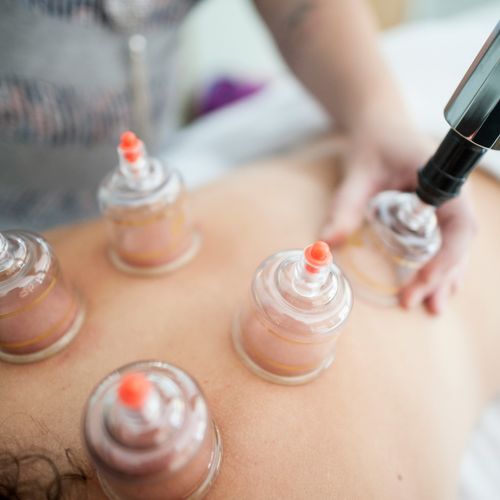Imagine a treatment that melts away muscle tension, boosts circulation, and promotes healing - all without medication. This isn't a futuristic breakthrough, but an ancient technique experiencing a modern renaissance: cupping therapy. Dry cupping and massage cupping are transforming how we approach pain management and wellness.
Understanding Dry Cupping and Its Powerful Benefits
Dry cupping involves placing specially designed cups on specific areas of the body and creating a vacuum effect. The practitioner uses either heat or a pump to remove air from the cup, causing the skin and underlying tissue to be gently drawn upward. This suction can be left in place for several minutes or quickly released, depending on the treatment goals.
The power of cupping lies in its ability to stimulate the body's natural healing processes. The suction increases blood flow to targeted areas, bringing oxygen and nutrients while removing metabolic waste. This enhanced circulation can accelerate healing, reduce pain, and promote overall wellness. Cupping creates a therapeutic effect by:
Increasing blood flow to the treated area, which can speed up healing and reduce inflammation
Stretching and separating muscle and connective tissue layers, releasing adhesions
Stimulating the nervous system, which can help modulate pain signals
Promoting lymphatic drainage, aiding in the removal of toxins and cellular debris
Some of the many benefits of dry cupping include:
Pain Relief: Many patients experience significant reduction in chronic back, neck, and joint pain. The increased blood flow and tissue manipulation can help alleviate deep-seated tension and discomfort.
Muscle Relaxation: The suction helps release tight knots and tension in muscles, promoting a sense of physical ease and improved flexibility.
Improved Circulation: By drawing blood to specific areas, dry cupping can enhance overall circulation, potentially speeding up healing processes and reducing inflammation throughout the body.
Stress Reduction: The physical relief often translates to mental relaxation, with many patients reporting a deep sense of calm and reduced stress levels after treatments.
Respiratory Support: When applied to the back and chest, dry cupping may help loosen congestion and improve breathing in some respiratory conditions.
Skin Health: The increased blood flow to the skin can promote a healthy glow and may even help with certain skin conditions by promoting cellular turnover.
Athletic Recovery: Many athletes use dry cupping to speed up recovery after intense workouts or competitions. The therapy can help reduce muscle soreness, improve flexibility, and potentially enhance performance.
A natural part of the dry cupping process is the appearance of circular marks on the skin where the cups were placed. These marks, which typically fade within a few days, are a sign that the treatment is stimulating blood flow and promoting healing. Many practitioners view these temporary marks as a positive indication of the body's response to the therapy. First-time recipients should be aware of this normal occurrence and can discuss any concerns with their practitioner before treatment.
Expanding Benefits of Dry Cupping: New Frontiers in Patient Care
As research into dry cupping progresses, we continue to uncover surprising applications for this time-honored therapy. While traditionally used for pain management and muscle relaxation, recent studies reveal its potential in unexpected areas of healthcare.
A randomized controlled trial published in Medicine (Baltimore) sheds light on a novel use of dry cupping in post-surgical care. This study found that applying dry cupping to a specific acupuncture point significantly reduced post-operative nausea and vomiting in patients. This discovery offers a potential drug-free method to enhance patient comfort during recovery, showcasing dry cupping's versatility beyond its conventional applications.
Exploring Sacred Cupping/Wet Cupping
Sacred cupping, or wet cupping, differs from dry cupping in its approach and techniques. This ancient practice is prevalent in East Asian medicine (acupuncture, moxa, Chinese herbs) and Sufi healing traditions, dating back at least 5,000 years. It involves recognizing and stimulating energy pathways within the body. Practitioners use glass or disposable cups on specific acupuncture points, sterilizing the area and making small pricks to release old energy.
By activating these points, wet cupping facilitates the flow of oxygen, promotes lymphatic drainage, provides pain relief, and enhances mobility. To complete the healing process, practitioners often use sound and sacred language to help patients achieve new paradigm shifts. While cupping is widely used for pain management, the sacred rituals and sound therapy in Sufism can also support mental and spiritual healing. Learn more about it here.
Integrating Cupping into Your Wellness Routine
Whether you're an athlete looking to improve performance, an office worker battling chronic tension, or simply seeking natural ways to enhance your well-being, cupping therapy offers a versatile solution. It's essential to work with a qualified practitioner who can tailor the treatment to your specific needs and health conditions.
The benefits of cupping therapy can vary from person to person. While some individuals may experience immediate relief, others might require multiple sessions to achieve optimal results. The number of treatments needed depends on the specific condition being addressed and your body's unique response to the therapy. Your practitioner will develop a personalized treatment plan based on your specific needs and health goals. Guidance on what to expect during and after each session will be provided, helping you understand the healing process and ensuring you get the most out of your cupping experience.
Embrace the Ancient Wisdom of Cupping
Cupping therapy bridges ancient practices with modern health needs, offering a versatile approach to wellness. As research continues to unveil its benefits, from pain management to stress relief, cupping is gaining recognition in contemporary healthcare. This natural, non-invasive technique provides an effective alternative for those seeking holistic methods to improve their health and vitality.













